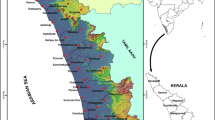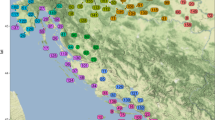Abstract
The present work investigates possible impact of the non-uniformity in observed land surface temperature on trend estimation, based on Climatic Research Unit (CRU) Temperature Version 4 (CRUTEM4) monthly temperature datasets from 1900 to 2012. The CRU land temperature data exhibit remarkable non-uniformity in spatial and temporal features. The data are characterized by an uneven spatial distribution of missing records and station density, and display a significant increase of available sites around 1950. Considering the impact of missing data, the trends seem to be more stable and reliable when estimated based on data with < 40% missing percent, compared to the data with above 40% missing percent. Mean absolute error (MAE) between data with < 40% missing percent and global data is only 0.011°C (0.014°C) for 1900–50 (1951–2012). The associated trend estimated by reliable data is 0.087°C decade–1 (0.186°C decade–1) for 1900–50 (1951–2012), almost the same as the trend of the global data. However, due to non-uniform spatial distribution of missing data, the global signal seems mainly coming from the regions with good data coverage, especially for the period 1900–50. This is also confirmed by an extreme test conducted with the records in the United States and Africa. In addition, the influences of spatial and temporal non-uniform features in observation data on trend estimation are significant for the areas with poor data coverage, such as Africa, while insignificant for the countries with good data coverage, such as the United States.
Similar content being viewed by others
References
Brohan, P., J. J. Kennedy, I. Harris, et al.,2006: Uncertainty estimates in regional and global observed temperature changes: A new data set from 1850. J. Geophys. Res. Atmos., 111, D12106, doi: 10.1029/2005JD006548.
Cowtan, K., and R. G. Way, 2014: Coverage bias in the Had-CRUT4 temperature series and its impact on recent temperature trends. Quart. J. Roy. Meteor. Soc., 140, 1935–1944, doi: 10.1002/qj.2297.
England, M. H., S. McGregor, and P. Spence, 2014: Recent intensification of wind-driven circulation in the Pacific and the ongoing warming hiatus. Nat. Clim. Change, 4, 222–227, doi: 10.1038/nclimate2106.
Hansen, J., R. Ruedy, M. Sato, et al.,2010: Global surface temperature change. Rev. Geophys., 48, RG4004, doi: 10.1029/20 10RG000345.
Hausfather, Z., M. J. Menne, C. N. Williams, et al.,2013: Quantifying the effect of urbanization on U.S. historical climatology network temperature records. J. Geophys. Res. Atmos., 118, 481–494, doi: 10.1029/2012JD018509.
Hofstra, N., M. New, and C. McSweeney, 2010: The influence of interpolation and station network density on the distributions and trends of climate variables in gridded daily data. Climate Dyn., 35, 841–858, doi: 10.1007/s00382-009-0698-1.
IPCC, 2013. Climate Change 2013: the Physical Science Basis. Contribution of Working Group I to the Fifth Assessment Report of the Intergovernmental Panel on Climate Change, T. F. Stocker, D. Qin, G. K. Plattner, et al., Eds., Cambridge University Press, Cambridge, UK and New York, NY, USA, 1535 pp.
Jones, P. D., 1994: Hemispheric surface air temperature variations: A reanalysis and an update to 1993. J. Climate, 7, 1794–1802, doi: 10.1175/1520-0442(1994)007<1794:HSATVA>2.0.CO;2.
Jones, P. D., and A. Moberg, 2003: Hemispheric and large-scale surface air temperature variations: An extensive revision and an update to 2001. J. Climate, 16, 206–223, doi: 10.1175/1520-0442(2003)016<0206:HALSSA>2.0.CO;2.
Jones, P. D., D. H. Lister, T. J. Osborn, et al.,2012: Hemispheric and large-scale land-surface air temperature variations: An extensive revision and an update to 2010. J. Geophys. Res. At-mos., 117, D05127, doi: 10.1029/2011JD017139.
Karl, T. R., A. Arguez, B. Y. Huang, et al.,2015: Possible artifacts of data biases in the recent global surface warming hiatus. Science, 348, 1469–1472, doi: 10.1126/science.aaa5632.
Lawrimore, J. H., M. J. Menne, B. E. Gleason, et al.,2011: An overview of the Global Historical Climatology Network monthly mean temperature data set, version 3. J. Geophys. Res. Atmos., 116, D19121, doi: 10.1029/2011JD016187.
McKitrick, R., 2010: A critical review of global surface temperature data products. SSRN Electronic Journal, 1–72, doi: 10.21 39/ssrn.1653928.
Meehl, G. A., A. X. Hu, B. D. Santer, et al.,2016: Contribution of the Interdecadal Pacific Oscillation to twentieth-century global surface temperature trends. Nat. Clim. Change, 6, 1005–1008, doi: 10.1038/NCLIMATE3107.
Morice, C. P., J. J. Kennedy, N. A. Rayner, et al.,2012: Quantifying uncertainties in global and regional temperature change using an ensemble of observational estimates: The Had-CRUT4 data set. J. Geophys. Res. Atmos., 117, D08101, doi: 10.1029/2011JD017187.
Ren, G. Y., Y. Y. Ren, Q. X. Li, et al.,2014: An overview on global land surface air temperature change. Adv. Earth Sci., 29, 934–946, doi: 10.11867/j.issn.1001-8166.2014.08.0934. (in Chinese)
Ren, G. Y., Y. H. Ding, and G. L. Tang, 2017: An overview of mainland China temperature change research. J. Meteor. Res., 31, 3–16, doi: 10.1007/s13351-017-6195-2.
Saffioti, C., E. M. Fischer, and R. Knutti, 2015: Contributions of atmospheric circulation variability and data coverage bias to the warming hiatus. Geophys. Res. Lett., 42, 2385–2391, doi: 10.1002/2015GL063091.
Turner, J., S. R. Colwell, G. J. Marshall, et al.,2004: The scar reader project: toward a high-quality database of mean antarctic meteorological observations. J. Climate, 17, 2890–2898, doi: 10.1175/1520-0442(2004)017<2890:TSRPTA>2.0.CO;2.
Vose, R. S., R. L. Schmoyer, P. M. Steurer, et al.,1992: The Global Historical Climatology Network: Long-Term Monthly Temperature, Precipitation, Sea Level Pressure, and Station Pressure Data. Rep. ORNL/CDIAC-53. NDP-041, 325 pp. Carbon Dioxide Information Analysis Center, Oak Ridge National Laboratory, Oak Ridge, TN.
Vose, R. S., D. Arndt, V. F. Banzon, et al.,2012: NOAA’s merged land–ocean surface temperature analysis. Bull. Amer. Meteor. Soc., 93, 1677–1685, doi: 10.1175/BAMS-D-11-00241.1.
Wang, K. C., 2014: Sampling biases in datasets of historical mean air temperature over land. Sci. Rep., 4, 4637, doi: 10.1038/srep04637.
Williams, C. N., M. J. Menne, and P. W. Thorne, 2012: Benchmarking the performance of pairwise homogenization of surface temperatures in the United States. J. Geophys. Res. Atmos., 117, D05116, doi: 10.1029/2011JD016761.
Xu, J. J., and A. M. Powell Jr., 2010: Ensemble spread and its implication for the evaluation of temperature trends from multiple radiosondes and reanalysis products. Geophys. Res. Lett., 37, L17704, doi: 10.1029/2010GL044300.
Author information
Authors and Affiliations
Corresponding author
Additional information
Supported by the National Natural Science Foundation of China (41490643 and 41675073), Jiangsu Provincial “333 Talents” Project and “Six Talents Highlands” Project, Priority Academic Program Development of Jiangsu Higher Education Institutions (PAPD), and Innovation Project of Jiangsu Province (KYLX16_0927).
Rights and permissions
About this article
Cite this article
Li, Z., Zhang, W. & Xu, H. Possible Impact of Spatial and Temporal Non-Uniformity in Land Surface Temperature Data on Trend Estimation. J Meteorol Res 32, 819–828 (2018). https://doi.org/10.1007/s13351-018-8037-2
Received:
Accepted:
Published:
Issue Date:
DOI: https://doi.org/10.1007/s13351-018-8037-2




